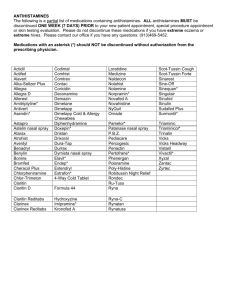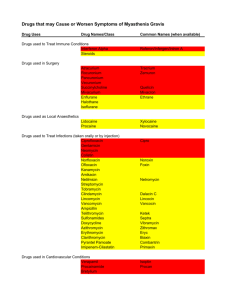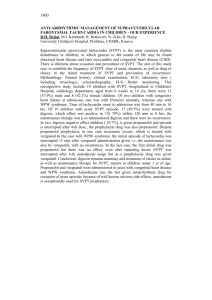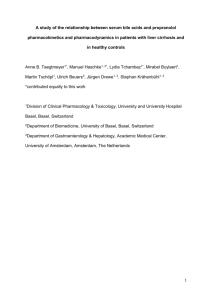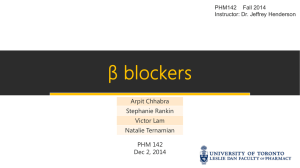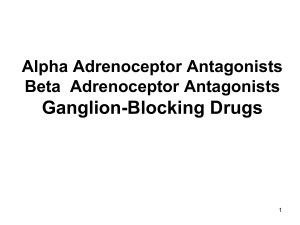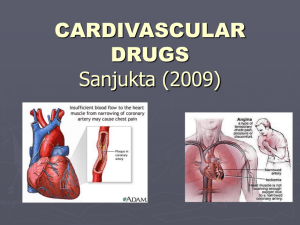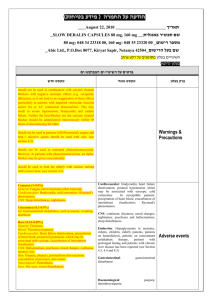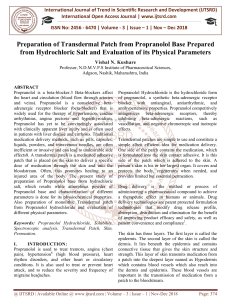3&4-Anti-Adrenergics
advertisement
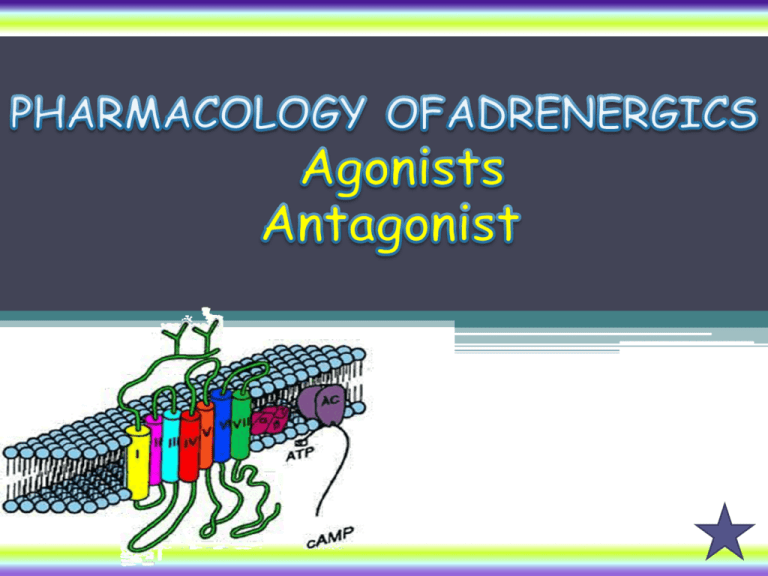
Adrenergic Neuron Blockers Sympatholytics Adrenoceptor Blockers Adrenolytics Form False Transmitters (alpha-2 agonists) Deplete Storage Inhibit Release & Enhance Uptake Alpha & beta- adrenergic receptor blockers Adrenergic Neuron Blockers [SYMPATHOLYTICS] a-methyl tyrosine Na Norepinephrine (NE) Dopa Tyrosine Tyrosine DA 2. RESERPINE 1. METHYLDOPA NE Depletes Stores False Transmitters Antihypertensive in PREGNANCY a2 3. Gaunthidine Inhibit Release a1 b1 b2 NET Enhance Uptake Adrenoceptor Blockers [ADRENOLYTICS] COMT What are a -adrenoceptors? Why they are called autoreceptors? Or presynaptics? 2 1. METHYLDOPA acts as agonist at a2-adrenoceptors. Thus inhibits the release Of NE leading to decrease blood pressure. 2. Clonidine similar to methyldopa acts as agonist at a2-adrenoceptors. Thus inhibits the release Of NE leading to decrease blood pressure. Adrenolytics Adrenergic Receptor Blockers a ADRENOCEPTOR BLOCKERS Non-Selective Blocks a1& a2 Blocks a1 a 1 blocker Selective Prazosin & Doxazosin Tamsulosin Short acting Long acting uroselective Phenoxybenzamine Indications Long acting Raynaud’s disease: induce peripheral vasodilatation 1. In Irreversible shock Can be used in hypertension & HF Benign prostatic hypertrophy 2. Before removal of Pheochromocytoma (BPH) ADRs to prevent Contracts bladder wall Postural hypotension, Hypertensive crisis syncope, Reversible fluid retention, Phentolamine head-ache, nasal stuffiness, How BPH Short acting ejaculation & Relaxes bladder neck impotence. & sphincters Irreversible b ADRENOCEPTOR BLOCKERS Pharmacodynamic Classification 1 According to extent of blocked of each type they are either Non-Selective Selective Block b1& b2 Propranolol, Timolol Block b1>> b2 Atenolol, Bisoprolol Block b1, b2 & a1 Labetalol, Carvedilol 2 According to presence of agonistic/antagonistic action (ISA) = PARTIAL AGONISTS or only antagonistic action Without ISA Propranolol, Timolol, Atenolol, Bisoprolol, Carvedilol With ISA Labetalol b ADRENOCEPTOR BLOCKERS Pharmacokinetic Classification According to their lipid solubility Lipophylic Hydrophilic Oral absorption Complete Irregular Liver Yes No metabolism t 1/2 CNS side effects Short Long High Propranolol, Timolol Labetalol > Carvedilol Low Atenolol, Bisoprolol 1. Non-Selective Blocker of b1 & b2 Dynamics 2. Has membrane stabilizing action 3. Has sedative action Actions PROPRANOLOL Kinetics Completely absorbed 70% destroyed during 1st pass hepatic metabolism, 90-95% protein bound, cross BBB Heart; by block b1 Inhibit heart properties cardiac output Has antianginal effects cardiac work + O2 consumption Has anti-arrhythmic effects excitability, automaticity & conductivity + by membrane stabilizing activity Blood Vessels [BV]; by block b2 Vasoconstriction blood flow to all organs except brain cold extremities + intermittent claudications BP; by block b1 & b2 Has antihypertensive action by Inhibiting heart properties cardiac output Vasoconstriction to kidney BV: renin & aldosterone secretion Presynaptic inhibition of NE release from adrenergic nerves Inhibiting sympathetic outflow in CNS PROPRANOLOL Actions Cont. Bronchi: by block b2 Bronchospasm specially in susceptible patients Intestine: by block b2 Intestinal motility Metabolism: by block mainly b2 In liver; Glycogenolysis Hypoglycaemia In pancreas; Glucagon secretion In adipocytes; Lipolysis In skeletal muscles; glycolysis Remember it is opposite to NE peripheral tremors & central nervous systems anxiety, therefore it is useful for treatemnt of tremors and anxiety PROPRANOLOL INDICATIONS of b-blockers Hypertension (Atenolol; Bisoprolol ; Metoprolol) Arrhythmias; Ventricular > atrial (propranolol) Angina (Atenolol; Bisoprolol) Myocardial infarction Cardioprotective death (Proranolol) Migraine [Prophylaxis] (Propranolol); Timolol Pheochromocytoma; used with a-blockers (never alone) (Atenolol) Chronic glaucoma (Timolol) Tremors (Prpranolol) Anxiety (Prpranolol) Hyperthyroidism (Prpranolol) * Controls symptoms; tachycardia, tremors, sweating * Protects heart against sympathetic over-stimulation. * Lowers conversion rate of T4 into T3 PROPRANOLOL Due to block of cardiac b1-receptors: Heart failure Bradycardia Hypotension Due to blockade of b2- receptor: (only with non-selective b-blockers) Asthma, emphysema, chronic bronchitis Cold extremities & intermittent claudication Erectile dysfunction & impotence Hypoglycemia & triglycerides ADR All b-blockers mask hypo-glycaemic manifestations devlop COMA Depression, nightmares, vivid dreams and hallucinations. Gastrointestinal disturbances. Sodium retention Hypersensitivity reactions: skin rash and fever. Selective Only (b1) Safer in : Asthma / Diabetes & Dyslipidemias Rauynald’s phenomenon & vascular diseases PROPRANOLOL Better in patients that exhibit excessive bradycardia Partial agonist Also in non compliant for fear of sudden stoppage Not useful in patients with AMI, angina & tachyarrhythmias With ISA Sudden stoppage will give rise to a withdrawal manifestations: Rebound angina, arrhythmia, myocardial infarction & hypertension So drug must be withdrawn gradually to prevent its happening Contraindications Depressed myocardial function as in; Uncompensated Heart Failure, Massive Myocardial Infarction, Heart Block. Hypotension Bronchial Asthma (safer with cardio-selective b-blockers). Peripheral vascular disease (safer with cardio-selective b-blockers). Diabetic patients > (Type I) (specially on Insulin) for fear of hypoglycaemia and also mask the sign and symptoms of Interactions PROPRANOLOL Pharmacodynamic Interactions Bradycardia / heart block with verapamil both induce A.V block Rebound hypertension & impaired tissue perfusion if used with cocaine, amphetamine or a-blocker overdose Attenuation of hypertensive effect with NSAIDs because they formation of vasodilating prostaglandins. HF with other cardiac depressants as quinidine. Claudications, parasthesia, …etc with ergot alkaloids in migraine. Enhanced neuromuscular blockade Tubocurarine Hypoglycaemia with anti-diabetic drugs ( insulin > sulfonylureas) > Non selective b-blockers LABETALOL Blocks b & a1 Rapid acting, non-selective with little ISA & local anesthetic effect Do not alter serum lipids or blood glucose Used in Severe hypertension in pheochromocytoma & hypertensive crisis during abrupt withdraw of clonidine May be used pregnancy-induced hypertension but better alphamethyldopa ADR; Orthostatic hypotension, sedation & dizziness CARVEDILOL Blocks b > a1 (so more vasodialating) Non-selective with no ISA & no local anesthetic effect. Has antioxidant Favorable metabolic profile. Used effective in congestive heart failure reverses its pathophysiological changes ADR; Edema Agents specifically indicated for hypertension Atenolol, Bisoprolol; Metoprolol Agents specifically indicated for cardiac arrhythmia Propranolol Agents specifically indicated for congestive heart failure Carvedilol, Bisoprolol Agents specifically indicated for myocardial infarction Atenolol, Propranolol Agents specifically indicated for glaucoma Timolol Agents specifically indicated for migraine prophylaxis Timolol, Propranolol
